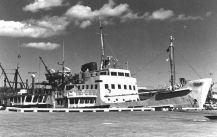A Princess born..... |
Radio CJCX Sydney Nova Scotia (Canada) started short-wave transmission and the USSR performed a nuclear test at Eastern Kazakh/Semipalitinsk. Dwight Gooden, pitcher for both the Yankees and the Mets was born, and Piet Moeskops, Dutch world champion cyclist died.
If you search the Internet for 16th November 1964, this is what you will find....
Somewhere in England, a newspaper almost certainly carried a story about the launch of a ship. OK, it was hardly world news, but this day saw the Queen of the Isles first take to the water.
November 16th 1964, The Duchess of Norfolk (or Gloucester, which seems more likely given the location of Charles Hill & Sons.... differing accounts on that one) broke the traditional champagne on the hull of the Queen of the Isles. There began a life of adventure, triumph, adversity and above all else, character. Many identities would be assumed and many people would tread her decks as the Queen’s voyage took her across the world.
The Queen of the Isles was built by Charles Hill & Sons Ltd. of Bristol, England at the Albion dockyard, now the site of Brunei's famous iron steamship, Great Britain. The original owners were called The Isles of Scilly Steamship Company, who had intended to call their new ship Islander, but the name was already registered with the UK Department of Transport, so the name Queen of the Isles was chosen instead. A change of name before the ship was even launched set a pattern that would follow the Queen throughout her life.
The owners plan was to operate the Queen alongside their other vessel, mv Scillonian and her maiden voyage in April 1965 was completed in a south-westerly gale under the command of Captain J.N.Thomas. The ship was originally designed to carry 300 day passengers between Penzance and the Isles of Scilly, a 42 mile open sea voyage.
Early newspaper reports indicate that the builders suffered 'quite considerable loss' also that the ship was an 'embarrassment to her owners'. This seems to indicate that the ship had a problem making a profit for her owners.
In some ways this early view epitomised the life of the Queen of the Isles, an enigma in her way, neither one thing nor the other. A vessel whose character was undeniable, whose build quality was exceptional, but as a concept, just something that didn’t quite fit.
Perhaps the concept was too grand, maybe the ship was too large for the trade envisaged, more likely it was just too expensive to build. Built to the highest standard, the Queen of the Isles was more a scaled down version of the grand P & O liners than a day ferry for which use she was intended.
Despite these problems of finance, civic welcomes were accorded the ship at Penzance and at St.Ives HRH the Duke of Edinburgh toured the ship in June, 1965.
The Queen of the Isles was equipped with seats for the passengers' use; all cabins and bunks were for the crew only. The voyage between Penzance and the Isles of Scilly took just under three hours at a sea speed of 14 knots. Original dimensions were given as l.o.a. 157 feet, gross tonnage 515 tons, net tonnage 213 tons, beam 30 feet, classed with Lloyds 100 A1 LMC.
Below decks the ship was fitted with twin Ruston Hornsby APC6M six cylinder oil engines each 462 KW with a fuel capacity of 16.5 tons. Oil consumption was given as 120 liters per hour, which proved to be one of the factors contributing to her demise in later years. Twin engine 'pocket passenger ships' were not cost effective in later years after the ship had been converted to carry a limited number of cruise passengers. The original design had a 100-ton cargo hold fitted in the forward well deck but this was converted to passenger accommodation in New Zealand in 1985.
 |
| The Queen of the Isles was built at Albion dockyard and launched in November 1964 |
Pages to view: |